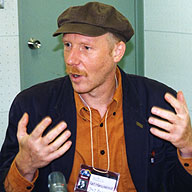An Interview with Ralf Marschalleck
Musical Troupe on the Run—The Energy of Sizzling Musicians
Explanations about Gypsy music seem unnecessary for the Fanfare Ciocarlia brass band shown in IAG BARI—Brass on Fire. The “discrepancy” and “admiration” triggered by words like “Gypsy” and “Roma” fall to the wayside before their performances. That’s how powerful they are in this film. Don’t try understanding them objectively. True understanding starts from moving your body and letting the music take over.

Things I wanted to capture on film
I wanted to convey the music of Fanfare Ciocarlia (Ciocarlia below), the living joy that erupts from the spirit, and their love and success. They give us an abundance that goes beyond the material. Ciocarlia was formed in a small village (Zece Prajini village in Romania) and their successes include touring the world. The village has a lot of activity now, with three bands going on world tours. Ciocarlia shows that success through music isn’t just a dream. The film covers around five years, with a year and a half from the beginning of production and my personal videotaping that started earlier.
The appeal of music
Music centered around stringed instruments is performed in southern Romania. (German producer) Helmut’s wife is from Clejani village, shown in the film. Taraf de Haouks is well known among the bands from the area. I’ve been friends with them from before I met Ciocarlia. They are wonderful people, and put on a great performance. I’d wanted to shoot a film about them, but they started working with a manager in Belgium right after the ’89 revolution so I couldn’t do it. On the other hand, in the northeast area of Moldavia brass bands are the mainstay. You feel like you’re being sucked into the high-speed rhythm and explosive sound, especially with Ciocarlia’s music. At 200 beats per minute, their rhythm is totally percussive. There’s also the smell of the earth in their sound. It’s the everyday sound of people who cultivate the earth. They are born musicians, dancers and actors and can perform the sounds of everyday life at any spot in any country. They remain unfazed, even when thrown into a completely unfamiliar world. One reason is they get on stage not for the money, but because for them performance is a kind of celebration, and the stage just happens to be there. The audience always dances at every performance. In Japan a guy in a suit and tie who was quietly seated at the beginning of the show suddenly took off his jacket an hour later and broke out dancing on his seat. By the end of the performance, everyone was dancing. It was too bad I couldn’t shoot it.
Music and tradition
Their parent’s generation mainly performed for ceremonies like weddings and funerals. At wedding ceremonies one song is twenty minutes and the performance goes on and on with dancing in the middle. Ciocarlia’s performances are different since they do many short pieces for live shows, but essentially they’re the same. Sometimes they play well known pop songs during performances and rehearsals. For example, they play ABBA songs to test out an instrument that’s come back from repairs or for encores. But, they invite foreign guest musicians to record CDs, so there might be fusion with other musical elements too. I think tradition lives on as people keep on adding to music with the times.
(Compiled by Kato Hatsuyo)
Interviewers: Kurokawa Michiko, Kato Hatsuyo / Interpreter: Watanabe Mari
Photography: Kurokawa Michiko / Video: Matsunaga Yoshiyuki / 2003-10-11
